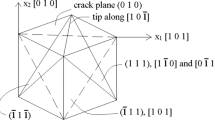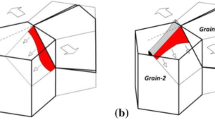Abstract
In this work, the crack tip strain localization in a face centered cubic single crystal subject to both monotonic and cyclic loading was investigated. The effect of constraint was implemented using T-stress and strain accumulation was studied for both isotropic and anisotropic elastic cases with the appropriate application of remote displacement fields in plane strain. Modified boundary layer simulations were performed using the crystal plasticity finite element framework. The consideration of elastic anisotropy amplified the effect of constraint level on stress and plastic strain fields near the crack tip indicating the importance of its use in fracture simulations. In addition, to understand the cyclic stress and strain behavior in the vicinity of the crack tip, combined isotropic and kinematic hardening laws were incorporated, and their effect on the evolution of yield curves and plastic strain accumulation were investigated. With zero-tension cyclic load, the evolution of plastic strain and Kirchhoff stress components showed differences in magnitudes between isotropic and anisotropic elastic cases. Furthermore, under cyclic loading, ratcheting was observed along the localized slip bands, which was shown to be affected by T-stress as well as elastic anisotropy. Negative T-stress increased the accumulation of plastic strain with number of cycles, which was further amplified in the case of elastic anisotropy. Finally, in all the cyclic loading simulations, the plastic strain accumulation was higher near the \(55^0 \) slip band.















Similar content being viewed by others
References
ABAQUS: ABAQUS Documentation. Dassault Systmes, Providence, RI, USA (2011)
Bari S, Hassan T (2000) Anatomy of coupled constitutive models for ratcheting simulation. Int. J. Plast. 16(3–4):381–409
Chaboche JL, Nouailhas D (1989a) Constitutive modeling of ratchetting effects part I: experimental facts and properties of the classical models. J. Eng. Mater. Technol. 111:384–392
Chaboche JL, Nouailhas D (1989b) Constitutive modeling of ratchetting effects part II: possibilities of some additional kinematic rules. J. Eng. Mater. Technol. 111:409–416
Chan K, Cruse T (1986) Stress intensity factors for anisotropic compact-tension specimens with inclined cracks. Eng. Fract. Mech. 23(5):863–874
Clayton, J.D.: Homogenization and incompatibility fields in finite strain elastoplasticity. Ph.D. thesis, Georgia Institute of Technology (2002)
Crone W, Shield T (2001) Experimental study of the deformation near a notch tip in copper and copper–beryllium single crystals. J. Mech. Phys. Solids 49(12):2819–2838. doi:10.1016/S0022-5096(01)00080-1
Cuitino A, Ortiz M (1992) Computational modeling of single crystals. Model. Simul. Mater. Sci. Eng. 1(3):225–263
Drugan W (2001) Asymptotic solutions for tensile crack tip fields without kink-type shear bands in elastic-ideally plastic single crystals. J. Mech. Phys. Solids 49(9):2155–2176
Facheris G, Janssens K (2013) Cyclic mechanical behavior of 316L: uniaxial LCF and strain-controlled ratcheting tests. Nucl. Eng. Des. 257:100–108
Facheris G, Janssens K, Foletti S (2014) Multiaxial fatigue behavior of AISI 316L subjected to strain-controlled and ratcheting paths. Int. J. Fatigue 68:195–208
Finney JM, Laird C (1975) Strain localization in cyclic deformation of copper single crystals. Philos. Mag. 31(2):339–366. doi:10.1080/14786437508228937
Flouriot, S., Forest, S., Remy, L.: Strain localization phenomena under cyclic loading: application to fatigue of single crystals. Computational Materials Science. 11th International Workshop on Computational Mechanics of Materials 26:61–70. doi:10.1016/S0927-0256(02)00393-2 (2003)
Forest S, Boubidi P, Sievert R (2001) Strain localization patterns at a crack tip in generalized single crystal plasticity. Scr. Mater. 44(6):953–958
Hancock J (1992) Constraint and stress state effects in ductile fracture. In: Argon AS (ed) Topics in Fracture and Fatigue. Springer, New York
Hancock J, Reuter W, Parks D (1993) Constraint and toughness parameterized by T. Am. Soc. Test. Mater. Phila. 1171:21–40
Kartal M, Cuddihy M, Dunne F (2014) Effects of crystallographic orientation and grain morphology on crack tip stress state and plasticity. Int. J. Fatigue 61:46–58. doi:10.1016/j.ijfatigue.2013.11.022
Kocks UF (1970) The relation between polycrystal deformation and single-crystal deformation. Metall. Trans. 1:1121–1143
Lee M, Lim H, Adams B, Hirth J, Wagoner R (2010) A dislocation density-based single crystal constitutive equation. Int. J. Plast. 26(7):925–938. doi:10.1016/j.ijplas.2009.11.004
Lempidaki, D., ODowd, N., Busso, E.: Crack tip stress fields for anisotropic materials with cubic symmetry. ECF 15 Advanced Fracture Mechanics for Life and Safety Assessments (2004)
Marchal N, Flouriot S, Forest S, Remy L (2006) Crack-tip stress–strain fields in single crystal nickel-base superalloys at high temperature under cyclic loading. Comput. Mater. Sci. 37(1–2):42–50. doi:10.1016/j.commatsci.2005.12.014
Marin, E.: On the Formulation of a Crystal Plasticity Model, Sandia report (2006)
Marin E, Dawson P (1998) Elastoplastic finite element analyses of metal deformations using polycrystal constitutive models. Comput. Methods Appl. Mech. Eng. 165(1–4):23–41. doi:10.1016/S0045-7825(98)00033-4
Mizuno M, Mima Y, Abdel-Karim M, Ohno N (2000) Uniaxial ratchetting of 316 FR steel at room temperature part I: experiments. J. Eng. Mater. Technol. 122:29–34
Pataky GJ, Sangid MD, Sehitoglu H, Hamilton RF, Maier HJ, Sofronis P (2012) Full field measurements of anisotropic stress intensity factor ranges in fatigue. Eng. Fract. Mech. 94:13–28. doi:10.1016/j.engfracmech.2012.06.002
Patil S, Narasimhan R, Mishra R (2008) A numerical study of crack tip constraint in ductile single crystals. J. Mech. Phys. Solids 56(6):2265–2286
Patil, S.D.: Constraint effects on stationary crack tip fields in ductile single crystals. Ph.D. thesis, Indian Institute of Science (2009)
Peirce D, Asaro RJ, Needleman A (1983) Material rate dependence and localized deformation in crystalline solids. Acta Metall. 31:1951–1976
Rice J (1974) Limitations to the small scale yielding approximation for crack tip plasticity. J. Mech. Phys. Solids 22(4):17–26
Rice J (1987) Tensile crack tip fields in elastic-ideally plastic crystals. Mech. Mater. 6(4):317–335
Roters F, Eisenlohr P, Hantcherli L, Tjahjanto D, Bieler T, Raabe D (2010) Overview of constitutive laws, kinematics, homogenization and multiscale methods in crystal plasticity finite-element modeling: theory, experiments, applications. Acta Mater. 58(1):1152–1211
Shah PD, Tan CL, Wang X (2006) T-stress solutions for two-dimensional crack problems in anisotropic elasticity using the boundary element method. Fatigue Fract. Eng. Mater. Struct. 29(5):343–356. doi:10.1111/j.1460-2695.2005.00990.x
Shield T, Kim KS (1994) Experimental measurement of the near tip strain field in an iron-silicon single crystal. J. Mech. Phys. Solids 42(5):845–873. doi:10.1016/0022-5096(94)90045-0
Sinha S, Ghosh S (2006) Modeling cyclic ratcheting based fatigue life of HSLA steels using crystal plasticity FEM simulations and experiments. Int. J. Fatigue 28(12):1690–1704
Varvani-Farahani A (2014) Fatigue ratcheting damage assessment of steel samples under asymmetric multiaxial stress cycles. Theor. Appl. Fract. Mech. 73:152–160
Williams ML (1957) On the stress distribution at the base of a stationary crack. J. Appl. Mech. 24(1):109–114
Author information
Authors and Affiliations
Corresponding author
Appendices
Appendix 1: Plastic strain field under monotonic load
Contour plots of maximum principal logarithmic plastic strain, \(\log \left( {\lambda _1^p} \right) \) for various levels of T-stress are presented respectively with the consideration of elastic isotropy and anisotropy. The plots in Fig. 14a show an excellent agreement with Patil et al. (2008) results. Similar occurrence of slip shear band and kink shear band were observed for different levels of T-stress. Mainly, activation of the slip systems caused the appearance of shear bands and they governed the shape of the plastic zone. For \(T = 0\), three shear bands (two slip shear bands and a kink shear band) were observed in agreement with the analytical results of Rice (1987). By contrast, for \(\frac{T}{{{\tau _0}}} = 2\) the slip band sited at an angle of \({125^0}\) to crack direction was more prominent though a small but visible kink shear band took place at \({90^0}\) along with slip shear band at \({55^0}\). For \(\frac{T}{{{\tau _0}}} = -2\), the contour was inclined at an angle of \({55^0}\) and the slip band (shear) at \({125^0}\) was disappeared in contour plots. Effect of elastic anisotropy was observed in the shape and spread of the plastic zone for different T-stress values as shown in plots Fig. 14b.
Appendix 2: Kirchoff stress components under monotonic load with elastic isotropy formulation
The normalized Kirchhoff stresses \(\frac{{{\tau _{11}}}}{{{\tau _0}}}\),\(\frac{{{\tau _{22}}}}{{{\tau _0}}}\),\(\frac{{{\tau _{12}}}}{{{\tau _0}}}\) and their angular variation at \(\frac{r}{{(J/\tau _0 )}} = 4\) from notch center are presented in Fig. 15 with consideration of elastic isotropy of aluminum single crystal. Similar angular variation of stress components and yield locus were observed as the results of elastic anisotropy formulation (Fig. 2) with slight variation in the magnitudes only.
Appendix 3: Plastic strain field under cyclic load with elastic isotropy formulation
Contour plots of \(\log \left( {\lambda _1^p} \right) \) after 20 cycles are shown in Fig. 16 for different levels of T-stress with the assumption of elastic isotropy. Discontinuities observed in these plots were almost same as the ones presented in Fig. 9 obtained with elastic anisotropy formulation but with slight variation in the spreads of plastic zones.
Rights and permissions
About this article
Cite this article
Deka, N., Jonnalagadda, K.N. Numerical investigation of crack tip strain localization under cyclic loading in FCC single crystals. Int J Fract 204, 29–53 (2017). https://doi.org/10.1007/s10704-016-0151-5
Received:
Accepted:
Published:
Issue Date:
DOI: https://doi.org/10.1007/s10704-016-0151-5





